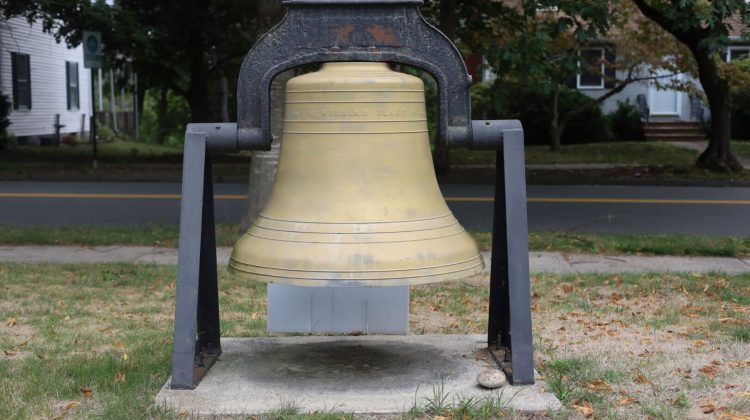SAUGUS — The Historical Society had its first meeting after the summer break, and President Laura Eisener focused her presentation on the history of bells. This is due to the nearing of America’s 250th anniversary, as bells have played an essential role in the country for centuries.
Eisener talked about how she began reading about information on the Battles of Lexington and Concord, all the way up to the signing of the Declaration of Independence.
“The more I read, the more I’d wake up in the middle of the night with bells ringing in my ears,” she joked. “Almost anything you did, a bell would be involved, and many of us remember them from our childhood, as we might have heard from school.”
Eisener started the presentation off with a photo of the Liberty Bell. She explained why the bell was cracked and how it had been moved from its original spot to a new one next door.
“It’s currently in a building called Liberty Bell Center in Independence National Historical Park. It’s right across the street from Independence Hall,” she said. Eisener also noted that upon being made, the bell quickly got its notorious crack. “It was recast and then developed another crack because it was rung so much. Cracks in bells are very common for any bells that are in frequent use,” she said.
Eisener said another important bell that was located in Pennsylvania was brought by William Penn, and it hung in a tree.
She then showed a photo of a stamp, which had an image of the Liberty Bell on it. The stamp was valued at 2 cents and was made almost 100 years ago, in 1926, for the 150th anniversary of the Declaration of Independence. She continued that over the years, the Liberty Bell had been featured on many stamps due to its status as a prominent historical symbol.
“The most famous bell, perhaps, is Big Ben, and I say that and you say, ‘Big Ben, that’s a clock, right? Or a tower?’ It’s a bell. People call the clock and the tower, the tower where Big Ben is,” she said.
Eisener explained that in England, it was common to name bells after people. It is believed Big Ben was named after Sir Benjamin Hall, who served as the Minister of Public Works. He was there when the bell was founded in the tower. She also said that Big Ben also had a crack in it.
“It cracked in September 1859. And I don’t know if they attempted to fix it… But, it’s still a usable bell,” she said.
Sticking to the topic of England, Eisener explained that bells still rang constantly there. “Great Britain has a very different system of ringing bells than any place in Europe. They call it change ringing… It’s not a tune or a song or a melody that you recognize usually… It’s more of a mathematical series of rings,” she said.
Eisener said that before technology, bells were rung to spread news. In Great Britain, a bell being rung could tell you that someone had died. She said that the number of rings could also tell you how old the person was, giving someone an idea of who had died.
She briefly discussed bells being used as ornaments during the holidays and also said that the song “Jingle Bells” was written in Medford, not too far from Saugus. James Pierpont, who wrote the song, was inspired by sitting on his porch watching sleighs with bells go by during the winter. He wouldn’t compose the song until he was living in Georgia, where he would join the Confederates.
Eisener also noted how bells were important during school, telling kids when it was time to come in from recess, change classes, and that the school day was over. They were also used on firehouses to alert volunteer firefighters that it was time to spring into action. Another reason for the bells to be rung would be in mourning or celebration.
Nearing the end of her presentation, Eisener showed photos of some of the bells around town, including one in front of the old Roby School, a bell at St. John’s Church, one at the First Congregational Church, and another that hung by a door at the Saugus Iron Works.

